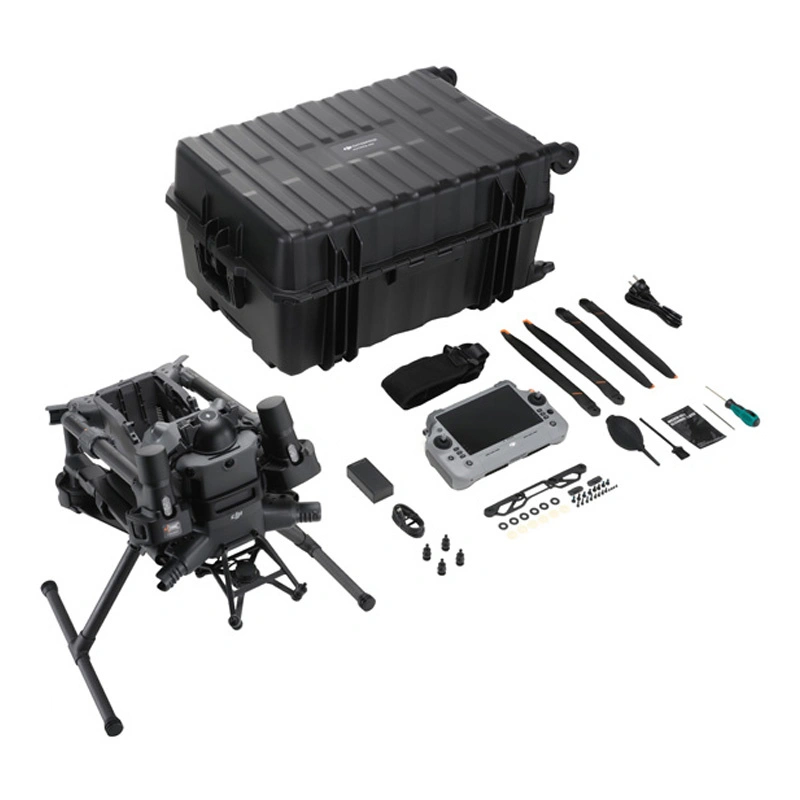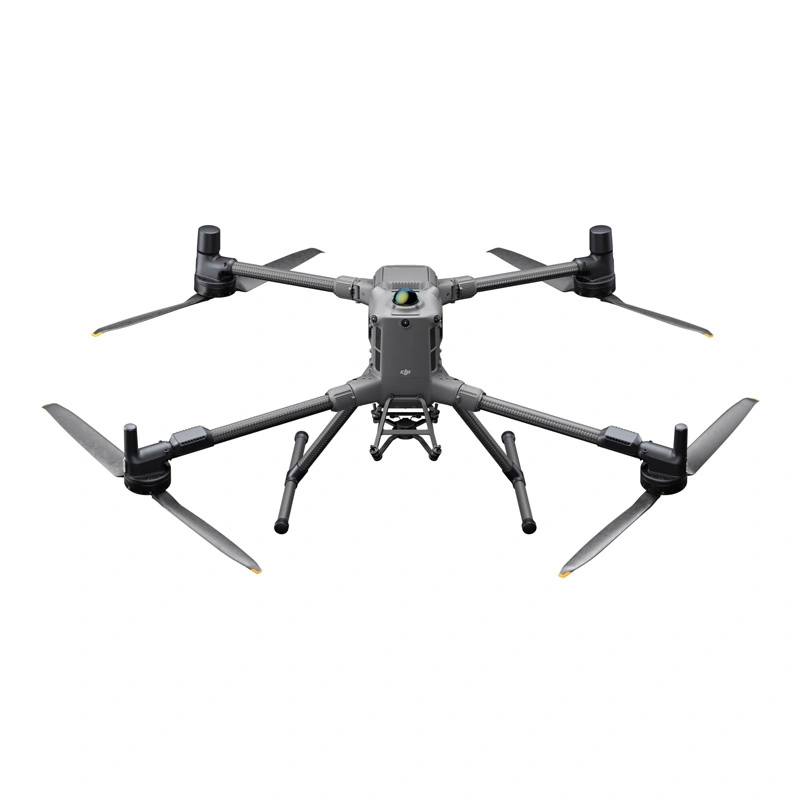DJI Matrice 400 + DJI Care Plus 1 year
Matrice 400 has a forward flight time of up to 59 minutes, a hover time of up to 53 minutes, and an IP55 protection rating. These capabilities make it a reliable tool for long-duration and continuous operations such as search and rescue, firefighting, and large-scale mapping, and more. The drone is compatible with a wide range of modules, including cameras, speakers, and lighting, allowing for customization to meet specific operational requirements. Furthermore, the DJI Matrice 400 features a rotating LiDAR sensor and mmWave radar, which provide accurate obstacle detection and avoidance capabilities.

Extended Flight Time, High Speed Performance
Matrice 400's flight capabilities are outstanding, offering up to 59 minutes of forward flight time even with a payload, and up to 53 minutes of hovering duration. These capabilities make it a reliable tool for long-duration and continuous operations such as search and rescue, firefighting, and large-scale mapping. It can also avoid large obstacles like buildings and mountains at flight speeds of up to 25 m/s.

Multi-Payload, Multi-Scene
Matrice 400’s maximum payload capacity of 6 kg allows it to easily meet the demands of a wide range of applications. Depending on the task, Matrice 400 can be equipped with the Zenmuse H30 Series, L2, P1, S1 Spotlight, V1 Speaker, Manifold 3, or third-party payloads, thereby expanding its capabilities and unlocking the full potential of the DJI ecosystem. The aircraft is equipped with 4 external E-Port V2 ports, enabling simultaneous mounting of up to 7 payloads.
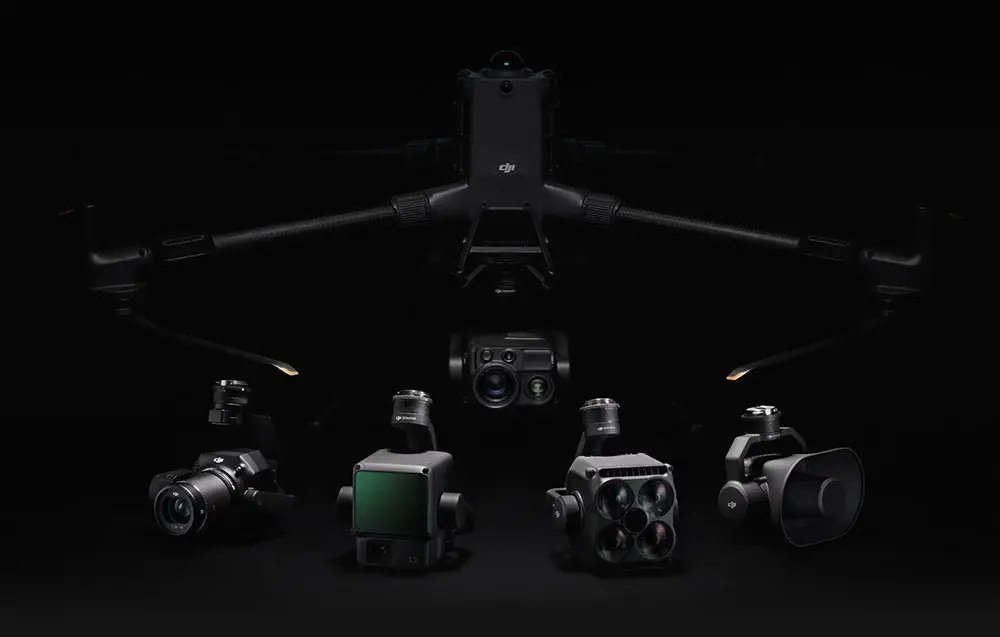
Built for Challenging Conditions
Conducting operations in challenging conditions? For the DJI Matrice 400, it's a breeze! Matrice 400 has a protection rating of IP55, allowing it to operate reliably in challenging conditions including heavy dust or rain. It also maintains stable performance across temperatures from -20° to 50° C (-4° to 122° F), delivering consistent results in both hot and cold conditions.
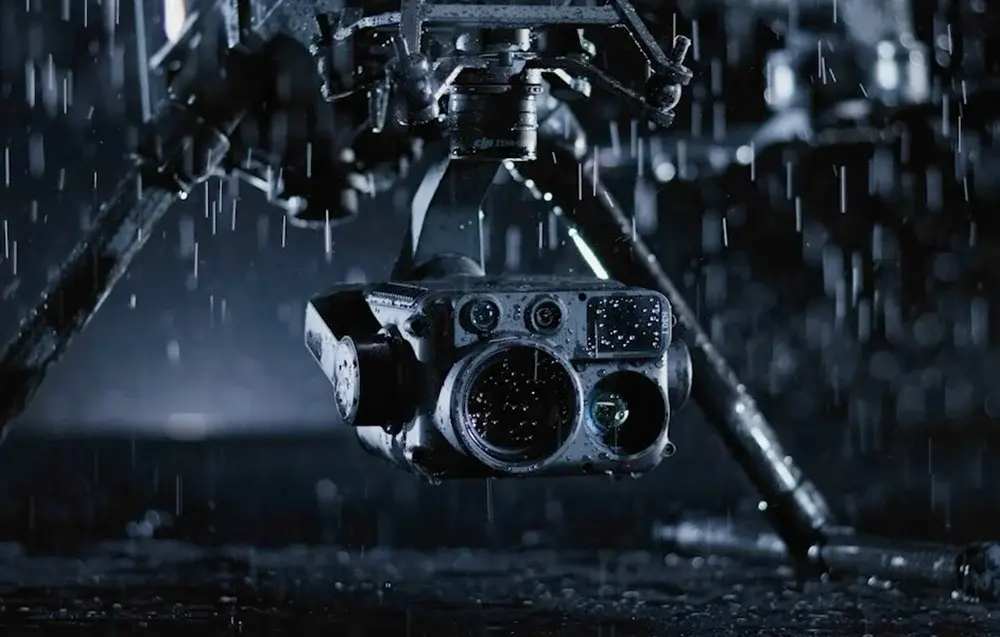
Power-Line-Level Obstacle Sensing
The Matrice 400's advanced obstacle sensing system integrates rotating LiDAR, high-precision mmWave radar, and full-color low-light fisheye vision sensors, pushing detection capabilities to unprecedented levels. The system detects even small obstacles like high-voltage power lines across mountainous terrain — even in darkness. It can penetrate rain and fog to sense its surroundings, providing enhanced safety in challenging weather conditions.
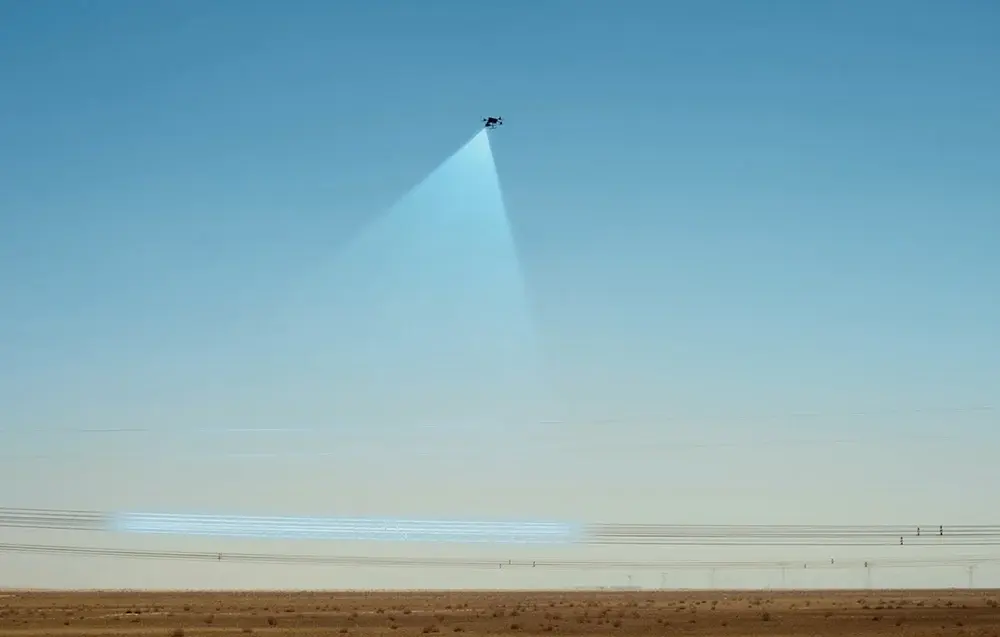
Robust Video Transmission
Thanks to the ten-antenna system on the aircraft and the high-gain phased array antenna system on the remote controller, the O4 Enterprise Enhanced Video Transmission System can achieve image transmission up to 20 km.
Matrice 400 also supports the sub2G frequency band, and when equipped with two DJI Cellular Dongle 2, it can automatically switch to the better available carrier network, providing a more stable signal even in urban interference environments or remote regions.
Matrice 400 has a built-in video transmission relay module. With this setup, one Matrice 400 can serve as a relay drone, flying high to provide relay signals for another Matrice 400 operating at a greater distance. This capability significantly extends the transmission range, making it ideal for search and rescue tasks as well as inspections in mountainous areas.
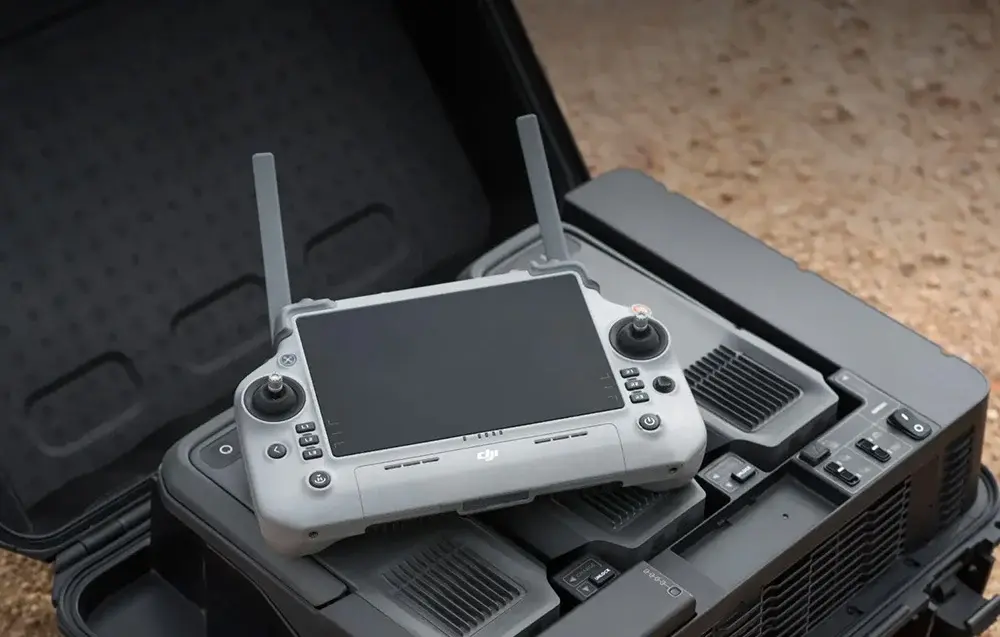
Safe and Reliable Flight
The omnidirectional sensing performance brought by rotating LiDAR, high-precision mmWave radar, and full-color low-light fisheye vision sensors provides Matrice 400 with strong positioning capabilities. It can fly stably close to glass-facade buildings or wind turbine blades and safely return from building edges, mountain bases, or bridge sides even when the return point has not been updated. The four full-color low-light fisheye vision sensors on the aircraft provide Full-Color Vision Assist to ensure safer flight.

Intelligent Flight Modes
Take advantage of the available modes to optimize each operation even further. Activate cruise control mode to pilot the drone in a specific direction without constantly pressing the control sticks, making long-distance flights or linear inspections easier. The FlyTo mode enables the drone to automatically adjust its flight path and speed based on the surrounding environment in emergencies or disasters, allowing it to reach a designated location without manual adjustments. Smart Track allows for precise subject positioning and automatic zoom adjustments, allowing you to switch between subjects easily. It can automatically reacquire a subject even if obscured briefly. POI enables continuous observation and 3D modeling of buildings while orbiting a designated area, greatly enhancing the efficiency of fixed-point observation and modeling tasks.
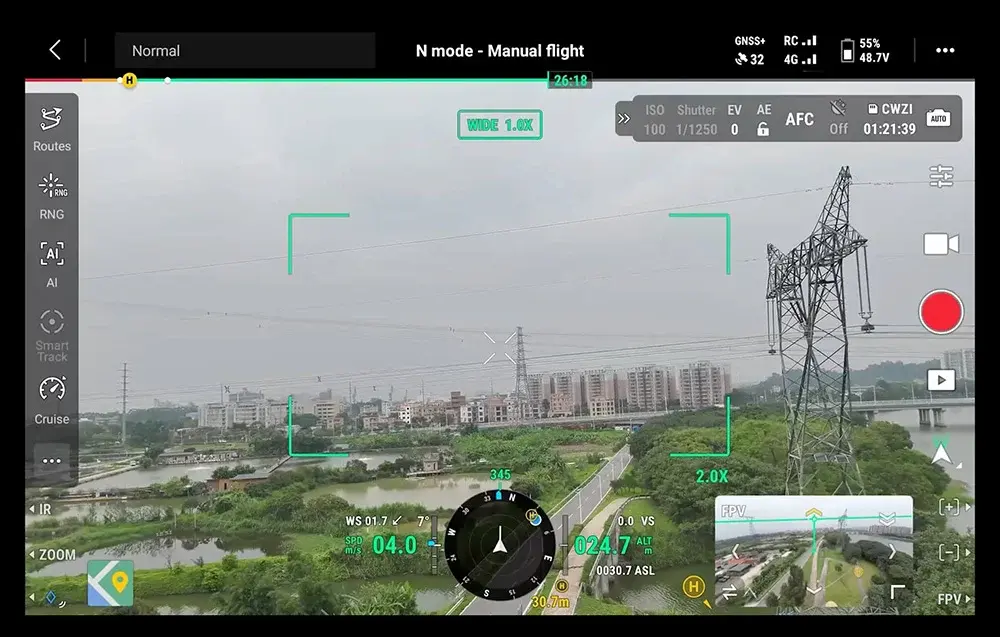
Enhanced Intelligence and Efficiency
With Zenmuse H30 Series' visible and thermal imaging, Matrice 400 can detect vehicles, vessels, and subjects during search and rescue operations or routine flights. It also supports switching to other models, enabling the expansion of application scenarios. Additionally, it supports high-res grid photos and features powerful tracking capabilities. Advanced AR features are also available. Power Line AR automatically detects frontal wire obstacles and displays easily recognizable AR lines on the remote controller’s screen. Map View AR can display the names of buildings and landmarks in real-time. AR Flight Waypoint shows real-time route for the drone during RTH, obstacle sensing, and FlyTo operations. Without modeling, you can mark points on the remote controller screen to obtain subject locations, draw lines to measure distances between multiple points, and outline areas to calculate their size. Measurement results can be synchronized to the DJI FlightHub 2 to enhance team efficiency.
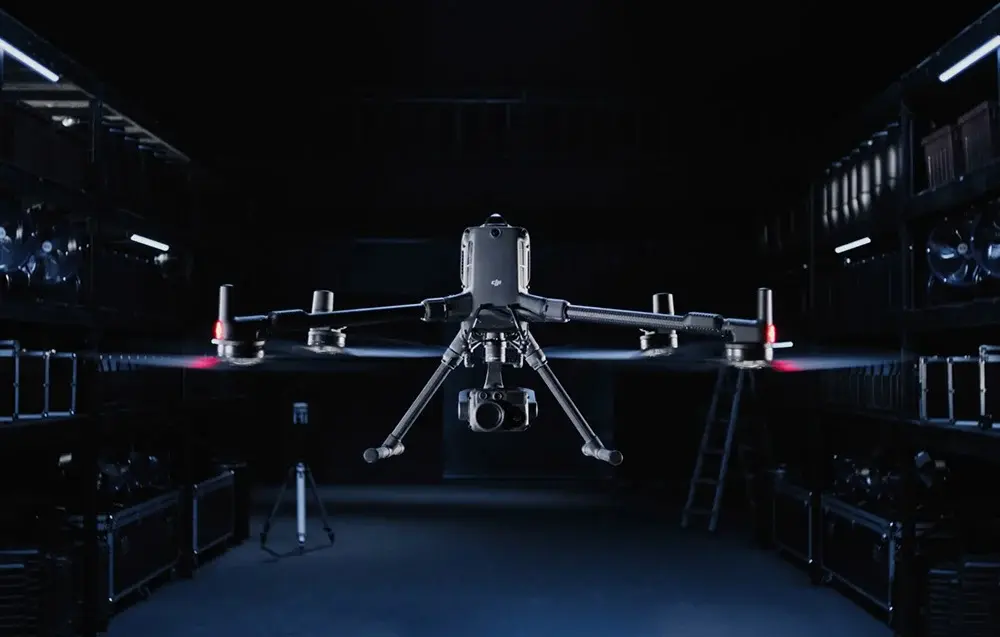
Further options available
Matrice 400 supports Real-Time Terrain Follow flight in any horizontal direction [15]. This feature can be enabled during both manual flight and automated flight routes, ensuring stable relative height to the ground.
During large-scale search and rescue operations, the size of ground subjects can be kept consistent on the remote controller screen, reducing the need for frequent zoom adjustments and improving efficiency. During mapping missions, a consistent ground sampling distance (GSD) can be maintained to obtain high-precision mapping data.
To address the needs of offshore operations such as maritime patrol and wind turbine inspection, Matrice 400 is equipped with the capability to take off from and land on ships, supporting takeoff from stationary vessels and landing on moving vessels.
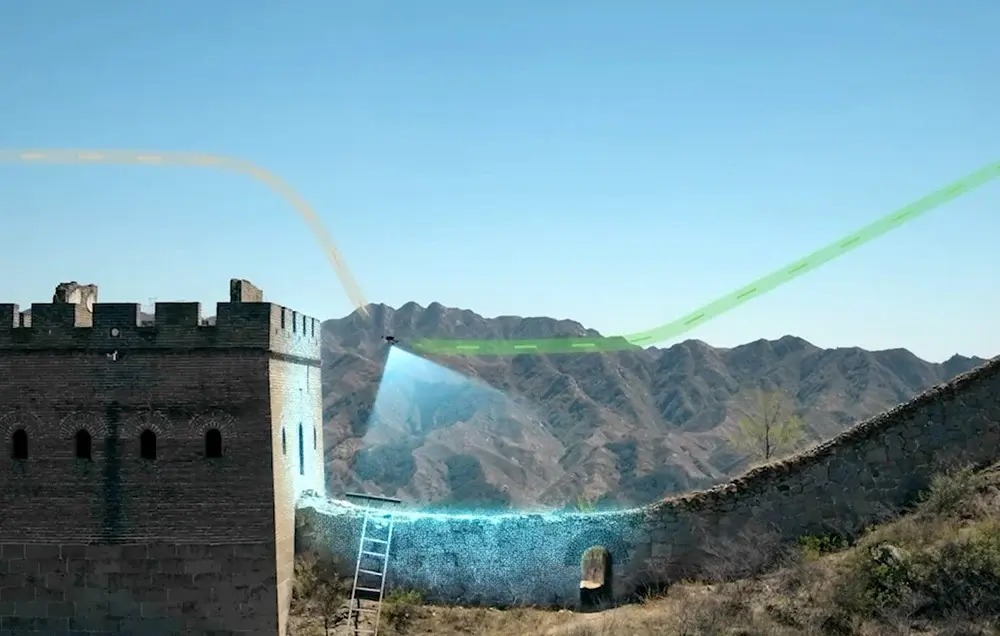
Easier Automated Operations
When equipped with the Zenmuse L2 LiDAR system, Matrice 400 can perform automated power transmission and distribution line following flights. It uses the rotating LiDAR to detect obstacles in real time and automatically bypasses crossing lines. Matrice 400 supports the planning and execution of slope and geometric routes via DJI Pilot 2 or DJI FlightHub 2. Whether conducting detailed aerial surveys of building facades, slopes, or other inclined surfaces, or collecting mapping data of individual buildings or structures, Matrice 400 can quickly plan slope or geometric routes to efficiently acquire high-precision data.

Comprehensive Accessory Upgrades
Enhance every operation with additional accessories. DJI Matrice 400 has compatibility with the D-RTK 3 Multifunctional Station and The DJI Cellular Dongle 2 that offers 4G network video transmission. Moreover, the drone integrates with DJI FlightHub 2 for managing operations, DJI Terra for 2D and 3D reconstruction, and DJI Modify for model editing. It also supports PSDK, MSDK, Cloud API, and model training tools—all of which further enhance its functionality. The DJI Matrice 400 also ensures data security, offering features such as AES-256 encryption and a Local Data Mode, in which the device operates entirely offline.
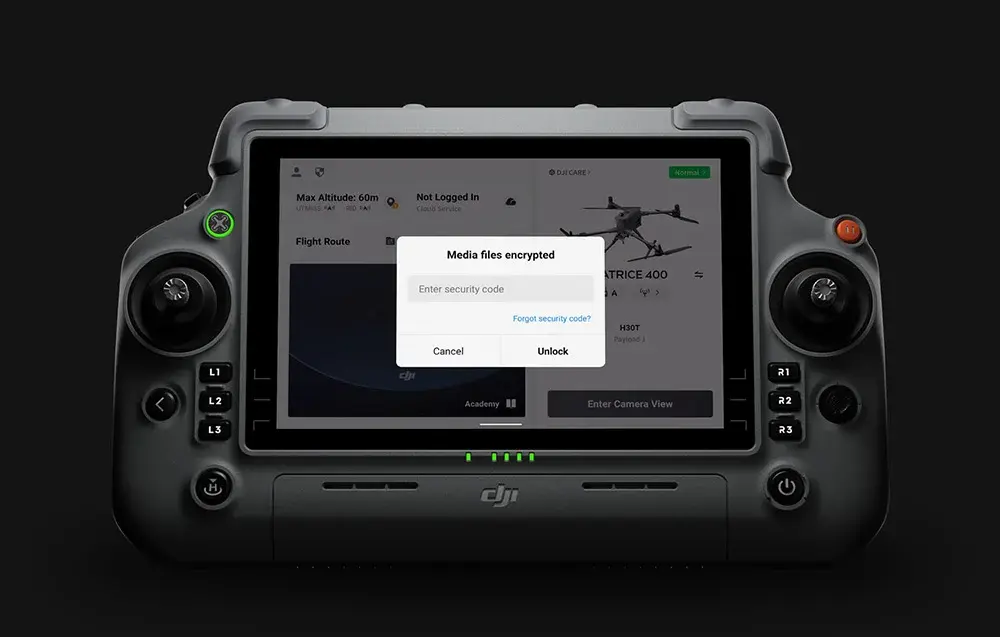
DJI Matrice 400 Specification
Takeoff Weight (with propellers) | Without Batteries: 5020±20 g With Batteries: 9740±40 g *The actual product weight may vary due to differences in batch materials and external factors. |
Max Takeoff Weight | 15.8 kg |
Dimensions | Unfolded: 980×760×480 mm (L×W×H) (with landing gear) Folded: 490×490×480 mm (L×W×H) (with landing gear and gimbal) *Maximum dimensions excluding propellers. |
Aircraft carrying case dimensions | 779×363×528 mm (L×W×H) |
Max Payload | 6 kg *The 6 kg payload is measured at the third gimbal connector under sea level conditions. Payload capacity decreases as altitude increases. For details, refer to the official user manual. |
Propeller Size | 25 inches |
Diagonal Wheelbase | 1070 mm |
Max Ascent Speed | 10 m/s |
Max Descent Speed | 8 m/s |
Max Horizontal Speed (at sea level, no wind) | 25 m/s |
Max Takeoff Altitude | 7000 m |
Max Flight Time (no wind) | 59 minutes *Measured with the aircraft flying forward at a constant speed of 10 m/s in a windless environment at sea level, carrying only the H30T (total weight 10,670 g), and from 100% battery level until 0%. Data is for reference only. Actual experience may vary depending on the environment, usage, and firmware version. |
Max Hover Time (no wind) | 53 minutes *Measured with the aircraft hovering in a windless environment at sea level, carrying only the H30T (total weight 10,670 g), and from 100% battery level until 0%. Data is for reference only. Actual usage time may vary depending on the flight mode, accessories, and environment. |
Max Flight Distance (no wind) | 49 km *Measured by the aircraft flying forward at a constant speed of 17 m/s in a windless environment at sea level, without external payloads, and from 100% battery level until 0%. Actual experience may vary depending on the environment, usage, and firmware version. |
Max Wind Speed Resistance | 12 m/s *Max wind speed resistance during takeoff and landing. |
Max Yaw Angular Velocity | Yaw: 100°/s |
Max Pitch Angle | 35° |
Operating Temperature | -20° to 50° C (-4° to 122° F) (without solar radiation) |
Global Navigation Satellite System (GNSS) | GPS + Galileo + BeiDou + GLONASS* * GLONASS is supported only when the RTK module is enabled. Equipped with standard airborne ADS-B In receiver and dual antennas, supporting reception up to 20 km. |
Hovering Accuracy Range (with moderate or no wind) | Vertical: ±0.1 m (with vision positioning) ±0.5 m (with satellite positioning) ±0.1 m (with RTK positioning) Horizontal: ±0.3 m (with vision positioning) ±0.5 m (with satellite positioning) ±0.1 m (with RTK positioning) |
RTK GNSS Accuracy | RTK Fix: 1 cm + 1 ppm (horizontal), 1.5 cm + 1 ppm (vertical) |
RTK Heading | Supports RTK heading with an accuracy better than 2° |
Airborne ADS-B In | Equipped with standard airborne ADS-B In receiver and dual antennas, supporting reception up to 20 km. |
Internal Storage | N/A |
Ports | USB-C Debug Port × 1: USB 2.0 E-Port V2 × 4: At the lower part of the drone, with 120W single-port power Cellular Dongle 2 Interface × 2: On the underside of the drone |
Propeller Model | 2510F |
Beacon | Built into the aircraft |
Ingress Protection Rating | IP55 *The rating is not permanently effective and may decrease due to product wear and tear. |
Gimbal Specification
Maximum Payload for Single Gimbal Connector | 1400 g *If exceeds, the gimbal damper lifespan will decrease from 1000 hours to 400 hours. |
Maximum Payload for Dual Gimbal Connector | 950 g |
Maximum Payload for Third Gimbal Connector | 3 kg for quick-release port, 6 kg for screw lock fastening |
Sensing Specification
Sensing Type | Omnidirectional binocular vision system (surround view provided by full-color fisheye vision sensors) Horizontal rotating LiDAR, upper LiDAR and downward 3D infrared range sensor Six-direction mmWave radar |
Forward | Measurement Range: 0.4-21 m Detection Range: 0.4-200 m Field of View (FOV): 90° (horizontal), 90° (vertical) |
Backward | Measurement Range: 0.4-21 m Detection Range: 0.4-200 m Field of View (FOV): 90° (horizontal), 90° (vertical) |
Lateral | Measurement Range: 0.6-21 m Detection Range: 0.5-200 m Field of View (FOV): 90° (horizontal), 90° (vertical) |
Downward | Measurement Range: 0.5-19 m The FOV to the front and rear is 160° and 105° to the right and left. |
Operating Environment | Forward, Backward, Left, Right, and Upward: Delicate texture on the surface, adequate light. Downward: The ground has rich textures and sufficient lighting conditions*, with a diffuse reflection surface and a reflectivity greater than 20% (such as walls, trees, people, etc.). * Sufficient lighting conditions refer to an illuminance not lower than that of a nighttime city light scene. |
Rotating LiDAR | Standard Measurement Range: 0.5-100 m @ 100,000 lux with 10% reflectivity target Measurement Range for Power Line: 35 m @ 30° @ 10,000 lux for 21.6 mm steel-core aluminum stranded wire with a relative body tilt angle of 30° to the left and right Field of View (FOV): 360° (horizontal), 58° (vertical) Point-Frequency: 520,000 points/second Laser Wavelength: 905 nm Eye Safety Level: Class 1 (IEC60825-1:2014), eye-safe |
Upper LiDAR (3D ToF) | 0.5-25 m at night (reflectivity > 10%) The FOV to the up and down is 60° and 60° to the right and left. |
Downward 3D Infrared Range Sensor | Measurement Range: 0.3-8 m (reflectivity > 10%) The FOV to the front and rear is 60° and 60° to the right and left. |
mmWave Radar | Measurement Range for Power Line: 36 m for a 12.5mm steel-core aluminum stranded wire 50 m for a 21.6mm steel-core aluminum stranded wire FOV: ± 45° (horizontal and vertical) *The mmWave radar function is unavailable in some countries/regions. |
FPV Camera Specification
Resolution | 1080p |
Field of View (FOV) | DFOV: 150° HFOV: 139.6° VFOV: 95.3° |
Frame Rate | 30fps |
Night Vision | Starlight Grade |
Video Transmission Specification
Video Transmission System | DJI O4 Enterprise Enhanced Video Transmission System |
Live View Quality | Remote Controller: 3-channel 1080p/30fps |
Operating Frequency and Transmitter Power (EIRP) | 902-928 MHz: < 30 dBm (FCC), < 16 dBm (MIC) 1.430-1.444 GHz: < 35 dBm (SRRC) 2.4000-2.4835 GHz: < 33 dBm (FCC), < 20 dBm (CE/SRRC/MIC) 5.150-5.250 GHz: < 23 dBm (FCC/CE) 5.725-5.850 GHz: < 33 dBm (FCC), < 14 dBm (CE), < 30 dBm (SRRC) *Operating frequency allowed varies among countries and regions. Refer to local laws and regulations for more information. |
Max Transmission Distance (unobstructed, free of interference) | 40 km (FCC) 20 km (CE/SRRC/MIC) *Measured in an unobstructed environment free of interference. The above data shows the farthest communication range for one-way, non-return flights under each standard. During your flight, please pay attention to RTH reminder on the DJI Pilot 2 app. |
Max Transmission Distance (with interference) | Strong interference (dense buildings, residential areas, etc.): approx. 1.5-6 km Medium interference (suburban counties, city parks, etc.): approx. 6-15 km Weak interference (open spaces, remote areas, etc.): approx. 15-40 km *Data is tested under FCC standard in unobstructed environments of typical interference. Only to serve as a reference and provides no guarantee as to the actual flight distance. |
Max Download Speed | Standard Mode: 80Mbps Downlink Playback Download: < 25 MBps Single-Channel Bitrate: ≤ 12 Mbps *The above data was measured under conditions where the aircraft and remote controller were in close proximity without interference. |
Antenna | WLAN Antenna × 8: 6 vertically polarized antennas and 2 horizontally polarized antennas sub2G Antenna × 2: 2 vertically polarized antennas 4G Antenna × 4 Operating Mode: 2T4R |
Others | Supports Dual Control Mode and 2-channel Cellular Dongle 2 |
Battery Specification
Model | TB100 |
Capacity | 20254 mAh |
Standard Voltage | 48.23 V |
Max Charging Voltage | 54.6 V |
Cell Type | Li-ion 13S |
Energy | 977 Wh |
Weight | 4720 ± 20 g |
Charging Temperature | 5° to 45° C (41° to 113° F) |
Discharging Temperature | -20° to 75° C (-4° to 122° F) |
Battery Heating | Single Battery: Support Onboard: Support Battery Station: Support |
Discharge Rate | 4C |
Max Charging Power | 2C |
Low-Temperature Charging | Supports low-temperature self-heating charging |
Cycle Count | 400 |
Intelligent Battery Station Specification
Model | BS100 |
Net Weight | 11.8 kg |
Dimensions | 605×410×250 mm (L×W×H) |
Supported Batteries | TB100 Intelligent Flight Battery, TB100C Tethered Battery, WB37 Battery |
Operating Temperature | -20° to 40° C (-4° to 104° F) |
Input | 100-240 V (AC), 50-60 Hz, 10 A |
Output | USB-C: TB100 Battery Interface: 100-110 V: Approx. 1185 W 110-180 V: Approx.1474 W 180-240 V: Approx. 2184 W WB37 Battery Interface: 100-240 V: Approx. 52 W USB-C: 5.0 V 3.0 A, 9.0 V 3.0 A, 12.0 V 3.0 A, 15.0 V 3.0 A, 20.0 V 3.25 A |
Number of Charging Channels | Three TB100 and two WB37 batteries |
Charging Mode | Ready-to-Fly Mode 90%; Standard Mode 100% Supports Fast Charging Mode and Silent Mode |
Charging Time | TB100/TB100C Battery From 0% to 100%: 220 V: 45 minutes (Fast Charging Mode); 110 minutes (Silent Mode) 110 V: 70 minutes (Fast Charging Mode); 110 minutes (Silent Mode) *Charging time is measured in a test environment with a temperature of 25° C. |
DJI RC Plus 2 Enterprise Enhanced Specification
Video Transmission System | DJI O4 Enterprise Enhanced Video Transmission System |
Max Transmission Distance (unobstructed, free of interference) | 40 km (FCC) 20 km (CE/SRRC/MIC) *Measured in an unobstructed environment free of interference. The above data shows the farthest communication range for one-way, non-return flights under each standard. During your flight, please pay attention to RTH reminder on the DJI Pilot 2 app. |
Video Transmission Operating Frequency and Transmitter Power (EIRP) | 902-928 MHz: < 30 dBm (FCC), < 16 dBm (MIC) 2.400-2.4835 GHz: < 33 dBm (FCC), < 20 dBm (CE/SRRC/MIC) 5.150-5.250 GHz: < 23 dBm (FCC/CE) 5.725-5.850 GHz: < 33 dBm (FCC), < 14 dBm (CE), < 30 dBm (SRRC) *Operating frequency allowed varies among countries and regions. Refer to local laws and regulations for more information. |
Antenna | 2T4R, 2.4GHz/5.8GHz multi-beam high-gain antenna sub2G Module: 2T2R |
Enhanced Transmission | Supports DJI Cellular Dongle 2 |
Wi-Fi Protocol | Wi-Fi Direct, Wireless Display, IEEE 802.11 a/b/n/ac/ax Supports 2×2 MIMO Wi-Fi, dual-band simultaneous (DBS) support for dual MAC, with data rates up to 1774.5 Mbps (2×2 + 2×2 11ax dual-band simultaneous) |
Wi-Fi Operating Frequency | 2.4000-2.4835 GHz 5.150-5.250 GHz 5.725-5.850 GHz *5.2 and 5.8GHz frequencies are prohibited in some countries. In some countries, the 5.2GHz frequency is only allowed for use in indoor. |
Wi-Fi Transmitter Power (EIRP) | 2.4 GHz: < 26 dBm, < 20 dBm (CE/SRRC/MIC) 5.1 GHz: < 23 dBm (FCC/CE/SRRC/MIC) 5.8 GHz: < 23 dBm (FCC/SRRC), < 14 dBm (CE) |
Bluetooth Protocol | Bluetooth 5.2 |
Bluetooth Operating Frequency | 2.400-2.4835 GHz |
Bluetooth Transmitter Power (EIRP) | < 10 dBm |
Screen Resolution | 1920 × 1200 |
Screen Size | 7.02 inches |
Screen Frame Rate | 60fps |
Brightness | 1400 nits |
Touchscreen Control | 10-Point Multi-Touch |
Built-in Battery | 2S2P High Energy Density 18650 Lithium-ion Battery (6500 mAh @ 7.2 V) 46.8 Wh |
External Battery | Optional, WB37 (4920 mAh @ 7.6 V) 37 Wh |
Charging Type | Supports PD fast charging, with a maximum 20V/3.25A USB Type-C charger |
Storage Capacity | RAM 8G + ROM 128G UFS + expandable storage via microSD card |
Charging Time | 2 hours for internal battery; 2 hours for internal plus external batteries. *When remote controller is powered off and using a standard DJI charger. |
Internal Battery Runtime | 3.8 hours |
External Battery Runtime | 3.2 hours |
Output Port | HDMI 1.4 |
Indicators | Status LED, battery level LED, connection status LED, tricolor light, brightness adjustable according to ambient light |
Speaker | Supports buzzer |
Audio | Array MIC |
Operating Temperature | -20° to 50° C (-4° to 122° F) |
Storage Temperature | Within one month: -30° to 45° C (-22° to 140° F) One to three months: -30° to 35° C (-22° to 113° F) Three months to one year: -30° to 30° C (-22° to 86° F) |
Charging Temperature | 5° to 40° C (41° to 104° F) |
Supported Aircraft Model | Matrice 400 |
Global Navigation Satellite System | GPS + Galileo + BeiDou |
Dimensions | 268×163×94.5 mm (L×W×H) *Width including external antenna folded, thickness including handle and controller sticks. |
Weight | 1.15 kg (without external battery) |
Model | TKPL 2 |
System Version | Android 11 |
External Interfaces | HDMI 1.4, SD 3.0, USB-C with OTG support, max 65W PD charging, USB-A with USB 2.0 support |
Accessories | Strap/waist support |
Supported Products
DJI Products Compatible With Matrice 400 | Gimbal Cameras: Zenmuse H30, Zenmuse H30T, Zenmuse L2 and Zenmuse P1 Accessories: Zenmuse S1 (drone spotlight), Zenmuse V1 (drone speaker), Manifold 3, DJI RC Plus 2 sub2G SDR Module, DJI Cellular Dongle 2 RTK Station: D-RTK 3 Multifunctional Station, D-RTK 2 Mobile Station Ecosystem Accessories: DJI X-Port DJI E-Port V2 Development Kit DJI E-Port V2 Coaxial Cable Kit DJI SKYPORT V3 Adapter Set DJI SKYPORT V3 Coaxial Cable Kit |
DJI Matrice 400 + DJI Care Plus 1 year Package Includes
- DJI Matrice 400 × 1
- DJI Care Plus for 1 year × 1
- DJI RC Plus 2 Enterprise Enhanced × 1
- DJI RC Plus 2 Strap and Bracket Kit × 1
- DJI Matrice 400 2510F Propeller × 1
- DJI Matrice 400 Gimbal Damper × 1
- DJI Matrice 400 Carrying Case × 1
- Rotating LiDAR Calibration Cover × 1
- Front Propeller Holder × 1
- Rear Propeller Holder × 1
- USB-C to USB-C Data Cable × 1
- WB37 Battery × 1
- E-Port V2 Rubber Port Cover × 2
- Rubber Plug Screws (2×2) × 4
- Screws and Tools × 1
- Cleaning Tools × 1
